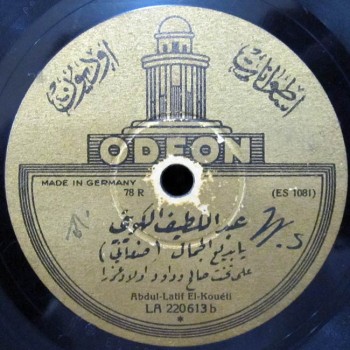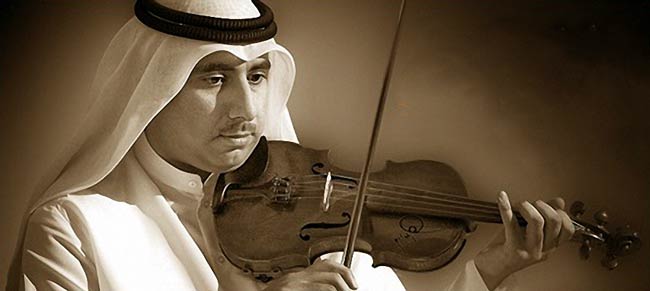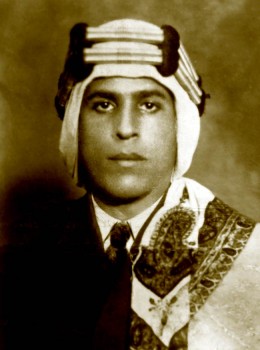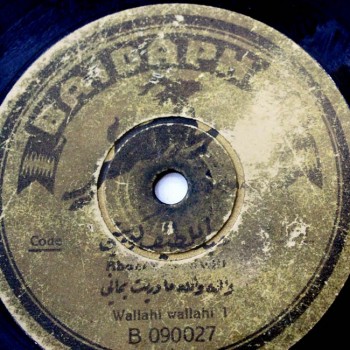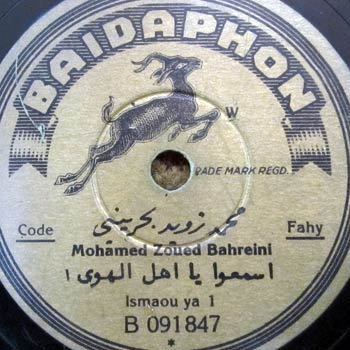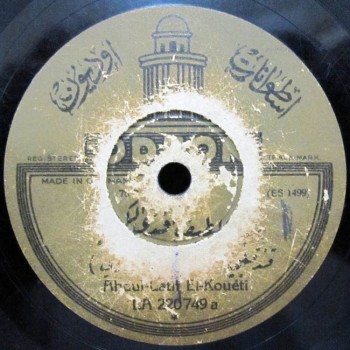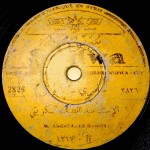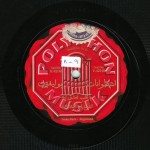The Arab Music Archiving and Research foundation (AMAR), in collaboration with the Sharjah Art Foundation (SAF), presents “Min al-Tārīkh”.
Dear listeners,
Welcome to a new episode of “Min al-Tārīkh”.
Today’s discussion about the History of Recording in the Arabian Gulf will be conducted by Mr. Kamal Kassar and an expert on the subject, Mr. Ahmad al-Salihi.
Welcome Mr. Ahmad.
Hello Mr. Kamal.
Could you tell us about the beginning of the recording era in Kuwait?
Non-commercial discs as well as commercial discs were recorded in Kuwait.
The non-commercial ones first appeared towards the end of Sheikh Mubārak al-Ṣabbāḥ’s era, i.e. between 1912 and 1915. A man from Zubayr in Iraq arrived in Kuwait and opened a café where he played cylinder records on an Edison cylinder recorder/record player he had brought along with him (cylinder records are called “Umm glās” in Kuwait where kūb (glass) is called “glās”). So, “Umm glās”, i.e cylinder records, reached Kuwait through this Zubayri man who recorded an old Kuwaiti muṭrib Khālid al-Bakr –who died in 1925. He recorded a collection of songs and played them in the café, which obviously attracted a lot of attention. Moreover, people were scared because this was the first time they had ever heard recorded voices.
The Crown Prince at the time Sālim al-Ṣabbāḥ –the son of Kuwait’s leader Sheikh Mubārak– who was religious and had apprehensions concerning recordings, forbade them while his father was away on a trip and he was in charge of Kuwait… he may even have exiled the Zubayri man who took his records to Bahrain where their destiny remains unknown. I did learn something though from Bahraini muṭrib Muḥammad ‘Īsa ‘Allāya –of Kuwaiti origin, who was born and died in Bahrain– who used to interpret Bahraini ṣawt. The deceased ‘Allāya said that as a child he heard a cylinder recording of Khālid al-Bakr, and probably made by this same Zubayri person. These known listed records were non-commercial recordings, and this is the first Kuwaiti recording known to us.
Are any of these records left that we can listen to?
No, we do not know what happened to them. No source has ever mentioned them, except for ‘Allāya’s story. They are not mentioned in any Bahraini source. Later on, commercial recording reached Kuwait, after Iraqi, Egyptian, Turkish and Persian records had arrived there. Some books mention that those records were well accepted by some and ill received by others. In an interview, Ṣāliḥ al-Kuwaytī said that he used to listen to records from Egypt, Iraq, Turkey and the Levant as a child, and interpreted a song of Munīra al-Mahdiyya whose record he used to listen to in Kuwait, when Kuwaitis had not yet started to make recordings and only listened to them.
The Kuwaiti recording era started in 1927 when Ḥasan Darsa, Baidaphon’s representative in Basra, was requested to scout for local talents. He first conducted a survey in South Iraq including in Al-‘Imāra and Al-Nāṣiriyya, and discovered Ḥuḍayrī Abū ‘Azīz, Nāṣir Ḥakīm and Dākhil Ḥasan later on, and Shkhayyir Sulṭān, Mas‘ūd ‘Amāratlī among many muṭrib who recorded with Baidaphon this same year, i.e. between 1926 and 1927 as mentioned by some Iraqi sources. So this first survey in Iraq possibly took place in 1926.
In 1927, this Baidaphon delegation conducted a survey outside Iraq, starting with the closest country, i.e. Kuwait. It is said that they met with numerous young muṭrib, many of whom refused, including unknown muṭrib Farḥān Abū Shāyi‘ who mentioned in an old interview that he was asked by a recording company to record his voice and refused because he disliked the idea and felt scared.
They also met with the only recorded 19th century muṭrib as all the others were from the 20th century, born in the 20th or the late 19th, imbued with this era’s culture/influence. The muṭrib I am referring to is Yūsuf al-Bakr, the brother of Khālid al-Bakr who recorded on a cylinder record as mentioned earlier. The younger brother Yūsuf al-Bakr, born in 1870 or 1875, is among those who learned their art from the old muṭrib and followed the old system. He agreed to record and went with the recording company to Basra where he had a disagreement with the representative who wanted a ‘ūdist and a violinist to accompany Al-Bakr’s performance. Al-Bakr replied that he was a ‘ūdist himself, that he did not want any other ‘ūdist to accompany him, and left. Another major refusal came from Farḥān Abū Shāyi‘.
Those who agreed include Ṣāliḥ ‘Abd al-Razzāq al-Naqī –a muṭrib who only recorded this collection with Baidaphon then stopped because he was a trader–; ‘Abd al-Laṭīf al-Kuwaytī; Ṣāliḥ ‘Izrā al-Kuwaytī; Dāwūd ‘Izrā al-Kuwaytī; along with ṭabl and mirwās player Su‘ūd al-Makhāyṭa. These went with the representative to Basra where they stayed for two days then took the train to Baghdad where they made a collection of records starting with a “ṣawt ‘arabī” record: muṭrib ‘Abd al-Laṭīf al-Kuwaytī’s “ ‘Awādhil dhāt al-khāl fī-hā ḥawāsidu” accompanied by Ṣāliḥ al-Kuwaytī (kamān), Dāwūd al-Kuwaytī (‘ūd), and Su‘ūd al-Makhāyṭa (mirwās).
Mr. Ahmad, will you play for us something from these records?
Yes. ‘Abd al-Laṭīf al-Kuwaytī made seven records including ṣawt “ ‘Awādhil dhāt al-khāl fī-hā ḥawāsidu”, ṣawt “Wa-qā’ilatun lammā aradta wadā‘ahā”, istimā‘ “Bada wa-ranat”, ṣawt “Ḥarrak shujūnī wa-iltihābī”, a fast pace ṣawt khayālī “Wa-qad kānat tudār ‘alayya rāḥun”, as well as sāmiriyya “Ṭērī yā-llī ‘ala ṭard al-hawa mā ymillī”, ṣawt “Wa-Allāh wa-Allāh mā darēt”, ṣawt arabī “ ‘Alimtum bi-annī mughramun bi-kum ṣabā”.
We can listen to “Wa-Allāh wa-Allāh mā darēt”.
(♩)
One year later in 1928, Odeon’s representative in Basra Shafīq Ḍbāra invited ‘Abd al-Laṭīf al-Kuwaytī to make a record accompanied by mirwās player Su‘ūd al-Makhāyṭa who had also accompanied him in his Baidaphon recordings. Ṣāliḥ and Dāwūd were both living in Baghdad, so they all met up and recorded a larger collection of records.
Mirwās and ṭabl player Su‘ūd al-Makhāyṭa also recorded melodies with the same record company, thus joining this group of muṭrib.
‘Abd al-Laṭīf al-Kuwaytī recorded with Odeon in Baghdad around 10 or 12 records that were very varied and included some of the tunes he had already recorded with Baidaphon. Moreover, he was accompanied for the first time by a qānūn –an instrument unknown to Kuwaitis until then– played by Iraqi qānūnist Ṣayūn Cohen who had accompanied Muḥammad al-Qubbanjī in his famous Berlin recordings and Ḥabība Masīka in Berlin, added to other great Iraqi muṭrib. Ṣāliḥ al-Kuwaytī accompanied him on the kamān and Dāwūd al-Kuwaytī on the ‘ūd.
Su‘ūd al-Makhāyṭa’s recordings include the same band excluding the qānūn, including the ‘ūd and the violin, with the muṭrib himself playing the percussions as Su‘ūd al-Makhāyṭa played the mirwās and sang lightly.
‘Abd al-Laṭīf recorded a few istimā‘ and ṣawt, added to other forms he had not recorded the first time, including khammārī and fann (art), the latter being a typical Kuwaiti form including fann najdī, fann ḥasāwī, etc… He recorded fann, khammārī, and ṣawt –obviously the major form–, and performed a larger variety of types in Kuwait.
Which Odeon recording will you play for us now?
I would like to play for you ṣawt “Yā badī‘ al-jamāl” by ‘Abd al-Laṭīf. He repeated the same tune on the second record-side with another qaṣīda “Ya ḥamām, ya ḥamām” that became one of the most famous ṣawt of the Kuwaiti repertoire. Even Nazim al-Ghazali who has a song on the Arab Nation, chose to interpret “Yā badī‘ al-jamāl” when he visited Kuwait, as a symbol of Kuwait or maybe the Gulf in general.
(♩)
In October 1929, ‘Abd al-Laṭīf al-Kuwaytī’s Odeon records sold out very quickly, and the satisfied record company asked him to record again. He agreed of course and went with ‘ūdist Maḥmūd al-Kuwaytī to Baghdad where he was told he would record in Cairo because the recording machine was not available… It seems there was only one recording machine that was taken from one Arab capital or region to another.
At that time, the machine was in Cairo, so ‘Abd al-Laṭīf al-Kuwaytī left Baghdad and went to Cairo’s Odeon studios in Muskī where he met with numerous Arab and Egyptian artists such as Umm Kulthūm and ‘Abd al-Wahāb, and recorded with Sāmī al-Shawwā a collection of ṣawt and other Kuwaiti fann. He was accompanied by Maḥmūd al-Kuwaytī (‘ūd) who was recording for the first time, and later recorded as a muṭrib, added to his ‘ūd playing with ‘Abd al-Laṭīf whom he also sang with.
‘Abd al-Laṭīf recorded a very large collection with Odeon, starting with 6 or 7 records and ending up with 10 or 11. To our knowledge, he also recorded 20 or more records with Odeon in Cairo, but there may be more.
He recorded with Sāmī al-Shawwā a collection to a beautiful style: we are acquainted with Sāmī al-Shawwā’s Egyptian or Oriental style, and with his Arabic and Turkish musical pieces. Yet he seems to have adopted a totally different personality in his interpretation of ṣawt, influenced by Kuwaiti instrumentalists. This influence added to his personal style resulted in a new beautiful style that marked his Kuwaiti recordings.
Play for us a special piece played by Sāmī al-Shawwā with this new Kuwaiti style he adopted.
We will listen to ‘Abd al-Laṭīf al-Kuwaytī singing the simple lyrics of “Fazzi qalbī fazzi qalbī”, a fann badawī sāmirī –the sāmirī being a “civilized” fann and this piece having Bedouin roots– accompanied only by a ‘ūd and a kamān and no percussions.
(♩)
In 1929, while ‘Abd al-Laṭīf al-Kuwaytī recorded with Odeon, another person from the Gulf, specifically from Bahrain, was also recording.
In 1929, the Baidaphon delegation represented by the Darsa sons arrived to Kuwait, then went one or two years later to Bahrain where they met with a number of muṭrib including Muḥammad Fāris who died in 1947 and Muḥammad Zuwayyid who died in 1982. They asked about a third muṭrib Dāḥī Bin Wulayd, the nahhām (singer employed on diving boats), but he was away on a diving trip and they only met with the other two.
They started by asking Muḥammad Fāris to sing in order to assess if his performance was fit for recording, and it was marvellous of course. But he refused to record with them for numerous reasons: first, they said he would have to record in Berlin where Al-Qubbanjī, Ḥabība Masīka, and Khumayyis Ternān, among other Arab artists, had recorded the previous year. He replied: “I already feel cold in Bahrain. What will happen to me in the snow?” and refused. Other sources say he was afraid the microphone and recording would steal his soul. People in the UK had such apprehensions too. Some of the first muṭrib were scared of recording, thinking the microphone would steal their soul… maybe because an artist had died right after recording… maybe they thought that records had to steal a soul in order to produce a voice. This belief was very strong. Ḥuḍayrī Abū ‘Azīz had refused to record the first time for this same reason, saying: “I was afraid the mic would steal my soul”. The point is Muḥammad Fāris refused… there are different versions to this story.
So Odeon ended up with only Muḥammad Zuwayyid who was a beginner at the time, a good one though. Zuwayyid was influenced by the current singing style in Kuwait and had adopted the personality of his teacher Muḥammad Fāris. He went to Baghdad were they made him leather clothes as he was supposed to go to Berlin, but then told him going there was not necessary anymore since the recording machine would reach Baghdad in a matter of one or two months. So Muḥammad Zuwayyid and violinist Sa‘d Abū Sayyūl waited for the recording machine in Baghdad, as well as for their turn since a number of other muṭrib were there, waiting for their turn to record.
During this period, he played and listened to Iraqi music whose influence on him appeared at a later stage. Muḥammad Zuwayyid recorded a collection of ṣawt mostly, and his first record was of a ṣawt ‘arabī “Salām yā zēn yā mayyās yā aḥwar”. The following is a significant information: Zuwayyid’s ‘ūd playing was stronger than his voice, so Odeon asked him to sing without the ‘ūd that he would only play during the instrumental sections. They placed a person behind him to give him the ‘ūd and to remove it throughout the performance, which was complicated. So they brought in Dāwūd al-Kuwaytī, an expert in Gulf voices and melodies, to play the ‘ūd and Ṣāliḥ al-Kuwaytī to play the kamān.
I had mentioned earlier that Sa‘d Abū Sayyūl accompanied him on the violin… but when they heard master violinist Ṣāliḥ al-Kuwaytī, they chose him. Sa‘d Abū Sayyūl played the percussions in these recordings and also recorded a collection of ṣawt including “Na‘īshu bi-dhikrākum” and “Salakhat ‘annī al-layālī min awd”. It is said that he also recorded “Yā Ḥammūd mā shuft el-khaḍar” and a type called khitām, i.e. the closure, a specific type of singing he recorded with the band that also accompanied him in the performance of a beautiful musical tawlīfa. The text was “Itsamma‘ū yā ahl el-hawa mā aqūl”.
Can we listen to it?
Yes
(♩)
Dear listeners, we have reached the end of today’s episode.
We will resume our discussion about the History of Recording in the Arabian Gulf in our future episode of “Min al-Tārīkh”.
“Min al-Tārīkh” was brought to you by Mustafa Said.
- 221 – Zakariyya Ahmed – 12 (1/9/2022)
- 220 – Zakariyya Ahmed – 11 (1/9/2022)
- 219 – Zakariyya Ahmed – 10 (11/25/2021)
- 218 – Zakariyya Ahmed – 9 (10/26/2021)
- 217 – Zakariyya Ahmed – 8 (9/24/2021)
- 216 – Zakariyya Ahmed – 7 (9/4/2021)
- 215 – Zakariyya Ahmed – 6 (8/28/2021)
- 214 – Zakariyya Ahmed – 5 (8/6/2021)
- 213 – Zakariyya Ahmed – 4 (6/26/2021)
- 212 – Zakariyya Ahmed – 3 (5/27/2021)
- 211 – Zakariyya Ahmed – 2 (5/1/2021)
- 210 – Zakariyya Ahmed – 1 (4/28/2021)
- 209 – W-al-Lāhi lā astaṭī‘u ṣaddak 2 (4/6/2017)
- 208 – W-al-Lāhi lā astaṭī‘u ṣaddak 1 (3/30/2017)
- 207 – Bashraf qarah baṭāq 7 (3/23/2017)

